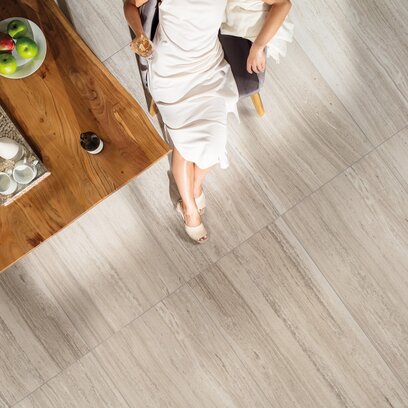The difference in temperature between the head and the ankles is important, especially the temperature distribution. This is also linked to the floor temperature requirements, which should be between 19 and 26 °C. In addition to the temperature differences, the thermal differences of the so-called radiant heat component of the environment are also strongly felt. This means in practice the amount of heat that is shared by radiation between the surface of the body and the various surrounding surfaces in the space.
In each floor of the house, great attention must be paid to the needs and possibilities for laying insulation and floors. If the house is not basemented and the slab is below the floor structure in contact with the ground, good thermal insulation of the slab itself is important. In this case, it is necessary to ensure that as little heat as possible escapes into the ground. Therefore, anything that the floor slab does not allow must be taken into account in the floor construction.

In new buildings today, when laying the floor, so-called perimeter insulation is usually used. When selecting perimeter insulation, it should be borne in mind that it can have different types and functions.
If the house has a basement, the lowest layer is usually the basement ceiling. When renovating buildings with basements and unheated basements, the basement ceiling is usually insulated, as this is very effective, simple and inexpensive. Additional (lighter) insulation can also be applied to the floor above.
On the first floor, the insulation is laid on the supporting structure due to its moisture-insulating properties. From the second floor upwards, the main waterproofing layer can usually be dispensed with, otherwise the floor structure is the same as on the first floor.
We have different types of thermal insulation that can be used in floors to improve the thermal efficiency of homes and buildings. Find out more about each material below and choose the one that suits your needs.
- Mineral wool: This is an insulating material that is often used for insulating floors. Mineral wool is available in the form of slabs or rolls. It is very popular because of its excellent thermal insulation properties. It is divided into glass wool and rock wool.
- Glass wool: This insulating material is made from molten glass. Glass wool is available in slabs or rolls and has very good thermal insulation properties. However, it is not recommended for floors due to its greater compressibility.
- Rock wool: Rock wool is a mineral insulating material similar to mineral wool. Due to its high fire resistance, it is suitable for areas where large temperature differences occur. It is mainly used for floors, as its greatest advantage is its acoustic properties, which surpass even polystyrene.
- Expanded polystyrene (EPS): a rigid foam that has good insulating properties and is resistant to moisture. It is available in the form of boards.
- Extruded polystyrene (XPS): Extruded polystyrene is a rigid foam with excellent thermal insulation. It is moisture-resistant and is suitable for insulating floors that come into contact with the ground.
- Polyurethane board (PIR): Polyurethane board is a medium-hard foam that is often used as spray foam. It has excellent insulating properties and can fill gaps tightly.
- Cellulose insulation: This type of insulation is often used as a filling for cavities or gaps in the floor. It is made from recycled newspaper and has good insulating properties.
The choice of a particular type of insulation always depends on the specific needs of the building, the local climate and many other factors. It is important to ensure correct installation and compliance with building regulations in order to achieve maximum thermal efficiency.
